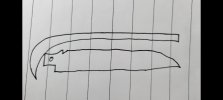Sean Yaw
Gold Member
- Joined
- Feb 26, 2019
- Messages
- 418
I gave up waiting to find a used surface grinder in Montana and bought a surface grinder attachment from Reeder. I find that it kind of rolls over edges and around holes, so it is not dead flat at those points, which is inconvenient for tangs of folding knives. Does anyone have any tips for avoiding this?

